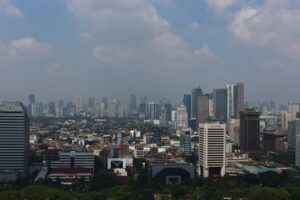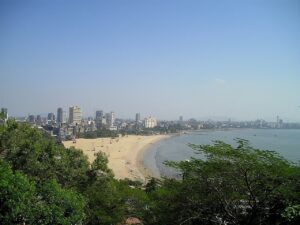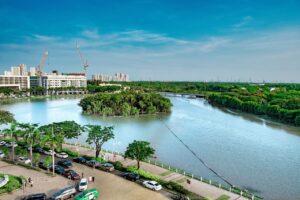If you were under the impression that climate change only meant hotter summer or colder winters for a few months of the year, then this will come as a shock to you.
Not only will climate change bring about drastic temperature changes, it will also increase the risk of starvation, and even make our cities disappear. With changing temperatures, our sea levels are also expected to change and since most of the populous cities around the world are located near rivers or larger water bodies, they are at risk of disappearing completely.
How can cities disappear?
The melting of ice-based land pieces and mountain glaciers contribute to rising sea levels, the most. Per NASA, the sea level rises 0.3cm per year due to the melting and thermal expansion of ice belts. On the other extreme, there is the phenomenon of desertification due to an imbalance between ecosystems that is taking turns to dry the lakes and water systems of the cities. The hydric stress due to climate change caused by human activity is driving desertification, and this is becoming more significant with each decade.
The vanishing of cities is alarming since they are also home to millions of people worldwide. Here’s a look at major cities that could disappear and what could be the underlying cause for their disappearance.
Miami, Florida

With a 6.1 million population, Miami is the second largest metropolitan area in the southeast. Image by- Mustangloe/ Pixabay
Located in South Florida, many factors contribute to the region’s woes. The rapidly rising sea levels and the porous limestone rocks that it’s built on are major factors. The sea level in South Florida has risen up to 12.7 centimetres since 1993, and it is expected to rise another 15 centimetres by 2030. However, Miami is elevating roads and installing pumps in the areas to prepare for future circumstances.
Jakarta, Indonesia
The capital of Indonesia is the fastest-sinking city in the world. If it goes unnoticed, most of its parts will be submerged underwater by 2050! Which is in most of our lives. Jakarta is situated around the Java Sea and 13 rivers run through it. So, frequent floods are not very surprising in this region.

Jakarta is sinking by an average of 1-15cm a year and almost half the city now sits below sea level. Image credit- Fuzz/ Pixabay
However, the main culprit for its sinking is excessive groundwater extraction for city dwellers’ everyday purposes. Piped water isn’t reliable or available in most areas, so people have no choice but to resort to pumping water from the aquifers deep underground. When the water is extracted, the land above it sinks, leading to land subsidence.
If the Government accelerates the provision of piped water to all residents and imposes a ban on extracting groundwater, it will likely slow down the sinking.
Venice, Italy

Venice is built on more than 100 small islands in the Lagoon in the Adriatic Sea. Image by- BMeyendriesch/ Pixabay
The floating city faces floods regularly. High tides and sirocco winds cause Acqua Alta (high waters) that last for a few hours. Venice is sinking at the rate of 0.2 centimetres every year. Rising sea levels globally add to the problem, but the city is also suffering due to coastal erosion and groundwater pumping.
In 2021, the government banned large cruise ships from sailing through Venice to save the Lagoon city from further pollution and damage.
Mumbai, India

The New York of India is at the verge of wiping out. Image credit- Simon/ Pixabay
According to NASA, the financial capital of India is also at risk of getting submerged by 2050. It is interesting to know that the city is built on a series of islands. Every year, the city experiences flooding during monsoon season, and IPCC has predicted that rainfall will increase in this century. The temperature is also rising in the city, and extreme weather events are more common, too.
In 2020, McKinsey India released a report that predicted that the intensity of flash floods will increase by 25% by 2050. A rise of 50 centimetres in sea level will affect the people living within one kilometre of coastline.
Alexandria, Egypt

For thousands of years, Alexandria’s fortunes have risen and fallen with the sea. Picture Courtesy- Bilderwelt68/ Pixabay
Alexandria is the historic city of Egypt, built by Alexander the Great in 331 BC. From Cleopatra’s palace to the remains of the Lighthouse of Pharos, Alexandria has treasures buried under it. Over the years, the seas have consumed Alexandria.
The city has faced several earthquakes and a tsunami. Due to these disasters, the coastline of ancient Alexandria is now gone. Rising sea levels are affecting the Nile River delta, the triangle where the Nile spreads out and drains into the sea. Egypt grows most of its crops near the delta.
According to the World Bank, Egypt is one of the countries that will be most vulnerable to the effects of climate change. The other inducers to this are its already high poverty rates and rapidly growing population.
Bangkok, Thailand
For more or less 10 million people living in the Thai city Bangkok, flooding is a common incident. The city experiences heavy rainfall and is built on soft clay that withstands the weight of urban development. The city normally experiences six months of rainy season every year from May to October.
However, conditions are soon expected to worsen for much of Bangkok. This is due to its vulnerability to the impacts of climate change and the ongoing sinking or land subsidence that is threatening the city. The Thai National Reform Council has predicted that Bangkok could sink underwater in less than 15 years.

For some parts of the city that are now only half a metre above sea level, these estimates are very worrying. Image credit- jprohaszka/ Pixabay
New Orleans, Louisiana
Known for its round-the-clock nightlife and vibrant live music scene, New Orleans is located on the Mississippi River. Being physically near the Gulf of Mexico, the city has spicy, singular cuisine reflecting its history as a melting pot of French, African and American cultures.
Hurricane Katrina treacherously destroyed the city through massive flooding. Moreover, NASA has revealed that some parts of New Orleans are sinking as much as 2 inches per year. Due to land subsidence and rising sea levels, 50% of the city is already below sea level. According to CNN reports, the city will be between 250 centimeters to 400 centimeters below sea level by 2100.

New Orleans is mostly flat, and areas around the French Quarter are just a little lower. Image credit- Charlottees/Pixabay
Lagos, Nigeria
Being a major African financial center, the city is the economic hub of Lagos and Nigeria at large. Annual floods are a part of everyday life in this coastal city. Coastal erosion and rising sea levels have been linked to flooding and poor urban planning of the city.

Lagos is partly built on the mainland and a string of islands. Image credit- kordi_vahle/Pixabay
CNN reports that the low-lying city, which is already less than 200 centimeters above sea level, may become unlivable by the end of this century. A study led by the Institute of Development Studies (IDS) states, “Sea level rise associated with climate change, estimated as potentially reaching 59 cm by 2100, is likely to worsen problems of coastal inundation, flooding, and intrusion of seawater into freshwater sources and ecosystems in Lagos.”
Ho Chi Minh city, Vietnam

By 2050, parts of Vietnam’s biggest metropolis could slip underwater, according to a report by the United Nations’ Intergovernmental Panel on Climate Change. Image by- Manle/ Pixabay
The most populated city of Vietnam fights to survive under siege from climate and man-made problems. Rapid development and groundwater pumping have caused subsidence. Around 45% of the city is less than a meter above sea level. The city has already sunk half a meter in the past 25 years, and by 2050, parts of Ho Chi Minh will be swallowed.
The floods ravage Vietnam’s largest city every year and now they’re getting more catastrophic.
Las Vegas, Nevada

The Las Vegas valley metropolitan area is largest within the Mojave desert. Image by- Pexels/ Pixabay
Las Vegas is called ‘The Meadows’ in Spanish, due to its natural springs. In 1962, after decades of groundwater pumping, the Las Vegas Springs ran dry, and today 90% of the water that flows through the valley’s faucets comes from the Colorado River by way of Lake Mead.
Las Vegas went 240 consecutive days without rainfall. From April 2020 to late April 2021, the city witnessed 3 centimetres of rain. The rain is also a lifeline to the Colorado River but due to less rainfall, the megadrought has turned to new levels. Vegas has lost 20% of the Colorado river since 2000 and another 10% would be lost by 2050.
If you enjoyed reading this article, you will love our newsletter. Sign up for free!


